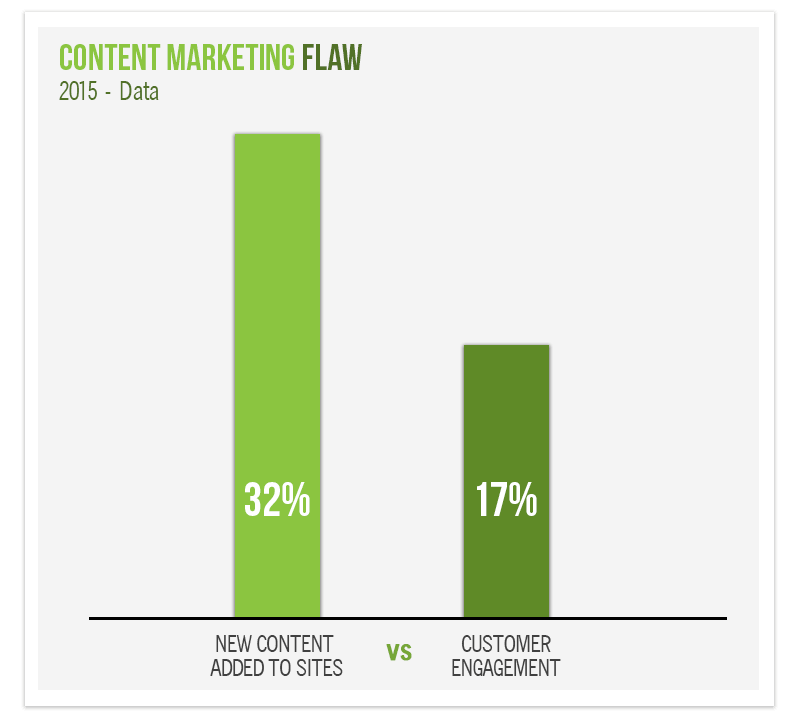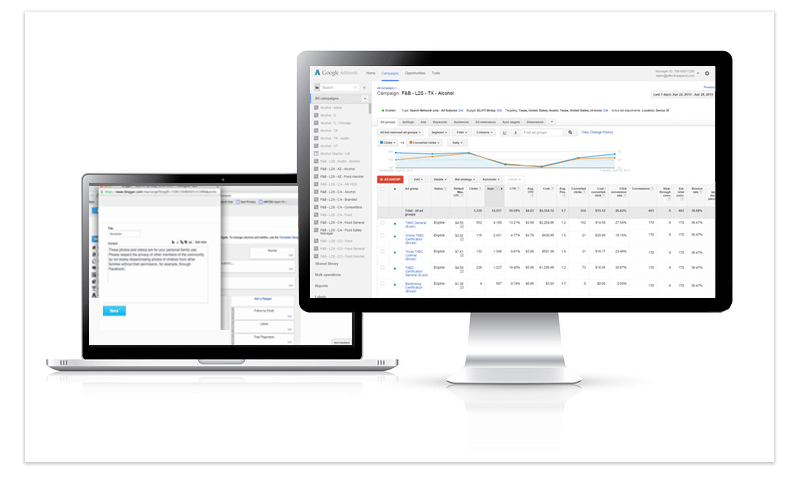
How Paid Search Marketing Supports Content Marketing
When you’re working out your budget for the year, you face the difficult task of figuring out which marketing tactics to focus your resources on. With limited budget to go around, there will always be winners and losers.
Business owners and marketers often struggle with knowing which tactics and approaches are really necessary, and which to invest the biggest part of the budget. It’s common enough to find articles online capitalizing on that indecision by comparing the relative value of different tactics. To someone trying to decide where to put their money and efforts, an article which compares PPC to content marketing can seem useful in helping you figure out which tactic to put more money toward this year.
The problem is, articles like that are often asking the wrong question. You don’t need to figure out which tactic is better; you need to find the right mix of tactics that support each other. Instead of pitting content marketing against paid search when working out your budget, you should think about how the two tactics can make each other stronger.
The Frustrating Flaw of Content Marketing
Content marketing has steadily become one of the most important parts of digital marketing over the past few years. 89% of companies now say they use content marketing, and 70% of those say they plan to increase their investment in the coming year.
It’s a powerful marketing approach that can produce impressive results if done well, but there’s a catch. The more companies that do content marketing, the more saturated the web becomes with content. A recent analysis found that brands are produce increasing amounts of content while getting less of a return for their efforts. In 2015, brands put out 32% more content, but saw 17% less engagement.

Brands that have been doing content marketing for years have an easier time because they were able to start building their audiences before content shock began to come into play. But the late adopters that started in the last five years or so are having a harder time replicating those results.
If your audience already has access to hundreds of articles on topics related to your brand that other companies published first – how are you supposed to compete for their attention?
One Solution: Paid Search Marketing
In response to the content saturation people face, brands are starting to realize the need to invest in content promotion in order to see results from the content they create. 87% of companies doing content marketing this year said they were planning to increase or maintain their budget for promotion. And the brands finding the most success with content marketing say they spend 30-50% of their content marketing budgets on paid content distribution.
Producing content on its own isn’t enough. You need to create paid search campaigns designed to ensure your audience sees the content you create.
While many brands still primarily see paid search ads as a way to promote products and deals, if you’re struggling to get your audience to pay attention to your content, it can be a useful tool for getting your content in front of the right people.
If you spend time and money on developing high-quality content and no one sees it, you get nothing out of it. It makes better sense to spend a little extra on ads to help you gain the audience your content needs to start doing its job.
The Benefits of Combining Content Marketing and Paid Search

PPC comes at a cost, but it can be an effective way to promote your content. Here are some of the ways it can be a beneficial part of your content strategy.
1. It’s faster than SEO.
One of the big benefits of content marketing is that fresh, high-quality content is good for SEO. But anyone with a basic knowledge of SEO knows that it’s a slow process. You have to put a lot of time and money into creating good, optimized content before you can expect to see much of a difference in the search results.
It’s worth doing, but if you want to start driving traffic to the content you’ve worked on faster while you wait for SEO to pay off, then PPC will do the trick. The results you get are immediate and definite. Paying to show up on SERPSs comes with a guarantee SEO can never offer.
2. It can help improve SEO.
SEO involves a lot of factors, but it helps to remember that the main goal of search engine algorithms is to recognize how useful and authoritative a website or webpage is in order to deliver users the best results. Metrics that signal people like your site – such as how long they spend on it once they get there, if they choose to share your content, and if they visit multiple pages before leaving – all serve to communicate to the search engines that your site is valuable to visitors.
As your PPC ads drive more people to your website and your content keeps them there engaging with your brand, that sends the kind of signals to the search engine that will help strengthen your website’s SEO over time. And if they like your content enough to share it and keep coming back, that does even more to demonstrate the value of your website.
It’s cyclical. People have to find your site first for this process to start, but once they do, a positive response to your content helps improve the visibility of your content online, which in turn brings more people to your site. PPC can help you start that cycle faster and more effectively.
3. Great content can make your PPC campaigns stronger.
Pairing PPC and content marketing doesn’t just make content marketing more effective. If you’re already doing paid search marketing, then you know that an ad that brings huge amounts of traffic to your website is only successful if the people it attracts actually stick around and take the actions you want them to once there.
If a click on your ads sends them to high-quality, relevant content, then they’re more likely to have a positive interaction with your brand as a result of that click. And you’re more likely to get your money’s worth for what the click costs you.
4. You can target your content to who’s looking for it.

One of the main goals of digital marketing is to be able to reach the right person at the right moment with precisely the information they’re looking for. The targeting options available with PPC give you a lot of power to make that happen.
Keyword targeting allows you to deliver up content that answers the questions and concerns a person is searching for right as they’re looking for the information your content provides. And with demographic and geographic targeting you can increase your ROI by only targeting the people most likely to benefit from your content and products.
There’s no free channel that allows you to get this specific with who you reach and when. As a result, paid search often yields better conversions than other marketing tactics. One study found that paid search ads resulted in 35% more conversions than traffic from organic search.
Content marketing is dependent on the ability to develop relationships with the people in your target audience, but every relationship has to start somewhere. With PPC, you create a starting point that more of the people you want to reach will have access to.
5. It helps you get more bang for your buck for content creation.
This is one of the most basic and convincing reasons to use paid search to promote your content. Doing content marketing well requires a big time and monetary commitment. But you can easily commit a significant part of your budget spend to content marketing without seeing a return if you can’t get your content in front of people.
Creating blog posts, ebooks, and videos isn’t easy, but for many marketers it’s harder to attract attention to their content assets than it is to create them to begin with. Paid search can get your content the eyeballs you need to make your hard work and financial investment in content marketing worth it.
6. You get more data to analyze success and refine your efforts.
A good content strategy is based on data. Deciding what topics to focus on, the keywords to use, and the content formats to pursue should all be based on what your marketing analytics tell you about your audience and what they respond to.
While content marketers have access to a number of data sources that provide some of the information they need without the help of paid search, the additional metrics you get from the Google AdWords campaigns you use to promote your content provide useful insights into the types of content, keywords, copy, and CTAs that are most effective with your target audience.
7. You can course correct as you go.
Unlike SEO, PPC isn’t a long game. If you focus on a keyword that turns out to be a no go for your SEO strategy, it’ll take months to realize it. With paid search, you can check the progress and success of your ads every day and make tweaks based on what’s working.
If any of your content promotion campaigns aren’t getting the traction you’d hoped, you can switch to a new approach long before you invest more money into the failing one. PPC’s fast results allow you to make fast decisions in order to realize success sooner.
Best Practices for Promoting Content with Paid Search
If you’re convinced that it’s time to use paid search to get more out of your content marketing, here are a few tips that will help you do it well.
1. Be strategic.
Before you start throwing together ads for various pieces of content and spending money on them, stop and make a plan first. Your content strategy should help inform your paid search promotion strategy and vice versa. Plan the two alongside each other so you can make sure they’ll both support the other.
Spend some time with the marketing analytics you have from your current and past PPC and content campaigns so you can bring the information you have on what works best for each format into your plan for bringing them together.
And don’t stop being strategic about your promotion once the campaigns are going, check in every few weeks to understand what’s working and tweak your strategy accordingly. Your PPC metrics can help you plan your content topics more effectively, and by paying attention to how well different pieces and types of content perform when coupled with paid search ads, you can determine the most effective content to focus your ad spend on as well.
2. Be targeted.

One of the best features of paid search is your ability to be extremely targeted. Use it. Set up your campaigns to focus on the demographics that most closely match your buyer personas. There’s no reason to pay for clicks from people that aren’t likely to turn into sales.
All of the content you create answers specific questions. Make sure your keyword targeting is relevant to the content you’re promoting and that the content will deliver on the promises of the ads you develop. Your targeting strategy is one of the most important factors in whether or not your content promotion campaigns will succeed. You may not get everything right from day one, but PPC makes it possible to analyze results and tweak campaigns as you go so you can improve your targeting with each passing day.
3. Promote your highest quality content.
Businesses practicing content marketing tend to produce a lot of content. It may not be worth your time and budget to promote every single blog post or video you create. Part of your strategizing should be to decide which pieces of content are most worth the cost of promoting with paid search.
Think about the questions you get the most frequently, factor in the keyword research you’ve done, and consider how much work is going into creating various pieces of content your team is working on. The content that is the most useful, in depth, or in demand should be what you focus your paid search campaigns on.
4. Keep the ads hyper relevant to the content.
Have you ever had the experience of the bait and switch? An ad or headline that promises one thing and delivers another does not encourage trust in the brand or make you want to continue a relationship with them. Your goal here isn’t to get as many clicks as possible (that would be costly). Your goal is to get clicks from the right people.
Make sure your ads accurately sell the piece of content your prospect will get on the other end of that click. You want them to be satisfied enough to gain a positive impression of your brand from the experience.
5. Focus first on attracting your audience, rather than gaining leads.
Content marketing should ultimately produce leads, but you have to be careful with how soon and how hard you start to push the sell. Your goal with the first interaction a prospect has with your content is to gain their trust enough to encourage them to become a part of your audience. You want them to keep coming back, or even better, sign up for your email list.
Hopefully, eventually, that will lead to a sale, but worry about that part later on the process.
6. Include a call to action in every piece of content you promote.

Avoiding the hard sell right off the bat doesn’t mean avoiding a CTA completely. Part of your strategy should be to figure out what you want each piece of content you promote to accomplish. Based on what you decide, craft a CTA that guides your prospect toward what you want them to do next. That could mean signing up for your email list, clicking a link to more content, or downloading a longform piece of content that goes more in depth on the subject.
Content marketing must be seen as effective. With the right strategy, paid search can be one of your best tools for bringing the content you create to the audience you most want to see it.




